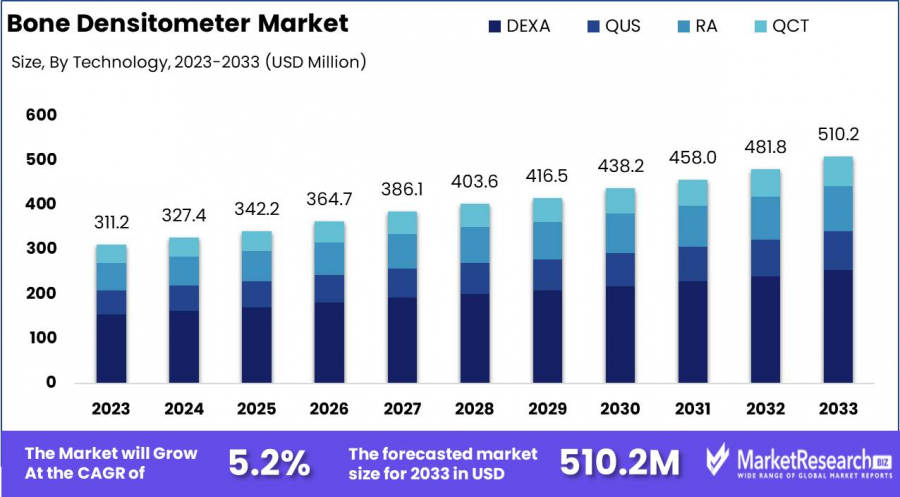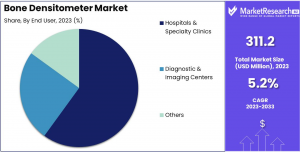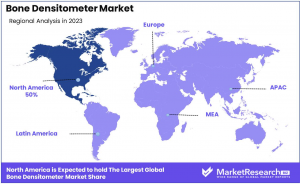
Bone Densitometer Market to Experience Steady Expansion, Set to Reach USD 510.2 Million by 2033
Global Bone Densitometer Market was valued at USD 311.2 Mn in 2023. It is expected to reach USD 510.2 Mn by 2033, with a CAGR of 5.2%
NEW YORK, NY, UNITED STATES, February 6, 2025 /EINPresswire.com/ -- Report Overview
The Global Bone Densitometer Market was valued at USD 311.2 Mn in 2023. It is expected to reach USD 510.2 Mn by 2033, with a CAGR of 5.2% during the forecast period from 2024 to 2033.
A bone densitometer is a specialized medical imaging device used to measure bone mineral density (BMD), primarily for diagnosing osteoporosis and assessing fracture risk. This non-invasive technology utilizes dual-energy X-ray absorptiometry (DXA), which provides precise measurements of bone strength.
The global demand for bone densitometers is rising due to the increasing prevalence of osteoporosis and age-related bone disorders. According to the International Osteoporosis Foundation (IOF), over 200 million people worldwide suffer from osteoporosis, making early detection crucial for prevention and treatment.
Modern bone densitometers are equipped with AI-driven analytics and digital imaging enhancements, improving accuracy and diagnostic efficiency. Hospitals, clinics, and research centers widely adopt these devices to ensure early detection and personalized treatment planning.
With the growing elderly population and increasing awareness about bone health, the bone densitometer market is expected to expand significantly. Manufacturers are focusing on portable and high-precision devices to improve accessibility. Innovations in radiation safety and automation further enhance patient comfort and diagnostic reliability. As osteoporosis cases rise, bone densitometry remains a critical tool in preventive healthcare, supporting early intervention and better patient outcomes.
Unlock Competitive Advantages With Our PDF Sample Report @ https://marketresearch.biz/report/bone-densitometer-market/request-sample/
Key Takeaways
- Market Value: The global Bone Densitometer Market was valued at USD 311.2 million in 2023 and is projected to reach USD 510.2 million by 2033, growing at a CAGR of 5.2% from 2024 to 2033.
- By Technology: Dual Energy X-ray Absorptiometry (DEXA) remains the dominant technology, accounting for 50% of usage due to its high accuracy in measuring bone mineral density.
- By Application: Osteoporosis and Osteopenia Diagnosis represent 60% of total applications, playing a crucial role in early detection and management of bone loss.
- By End User: Hospitals and Specialty Clinics account for 60% of market usage, relying on bone densitometers for precise bone health diagnostics.
- Regional Dominance: North America leads with a 50% market share, driven by a high prevalence of bone-related disorders and well-developed diagnostic infrastructure.
- Growth Opportunity: Rising osteoporosis screenings and preventive healthcare measures among aging populations present significant growth potential for the market.
How Artificial Intelligence (AI) is Transforming the Bone Densitometer Market ?
•Enhanced Diagnostic Accuracy: AI-powered bone densitometers improve bone mineral density (BMD) measurement precision by reducing human errors. Machine learning algorithms analyze DXA (Dual Energy X-ray Absorptiometry) scans, providing automated and standardized assessments for early osteoporosis detection. This ensures more consistent results across different healthcare facilities.
•Faster and Automated Image Analysis: AI accelerates scan processing and image interpretation, reducing diagnosis time. AI-based bone densitometers can automatically detect fractures, bone loss patterns, and abnormalities, helping radiologists and physicians make quicker and more informed decisions.
•Predictive Analytics for Osteoporosis Risk Assessment: AI models assess patient risk factors, lifestyle habits, and genetic predisposition to predict osteoporosis likelihood before symptoms appear. This allows for preventive interventions, reducing future fracture risks and healthcare costs.
•AI-Driven Workflow Optimization: AI automates scan acquisition, data processing, and report generation, minimizing technician workload and enhancing clinical workflow. This leads to higher patient throughput in hospitals and diagnostic centers, improving operational efficiency.
•Personalized Treatment Plans: AI integrates bone density results with patient medical history and lifestyle data to create personalized osteoporosis management plans. This enables targeted therapies, optimizing medication use and physical activity recommendations for better patient outcomes.
•Remote and Telehealth Integration: AI-enabled densitometers support remote bone health monitoring by transmitting scan data to cloud platforms. This allows specialists to review results remotely, making osteoporosis screening more accessible, especially in rural or underserved areas.
•AI-Driven Research and Drug Development: AI assists researchers in analyzing large-scale bone health data, identifying new treatment approaches, and improving osteoporosis drug development. AI-driven analytics enhance clinical trials by predicting drug responses based on bone mineral density trends.
Segmentation Analysis
• By Technology Analysis: Dual Energy X-ray Absorptiometry (DEXA) led the Bone Densitometer Market in 2023, accounting for over 50% of the market share. DEXA is the gold standard for bone mineral density (BMD) measurement, known for its high accuracy, reliability, and efficiency in diagnosing osteoporosis and fracture risk assessment. Other technologies include Quantitative Ultrasound (QUS), which is portable and radiation-free but has lower precision. Radiographic Absorptiometry (RA) is used in certain settings but lacks DEXA’s accuracy. Quantitative Computed Tomography (QCT) offers detailed 3D imaging, especially for the spine and hip, but has a smaller market share due to its higher cost and radiation exposure compared to DEXA.
• By Application Analysis: Osteoporosis and Osteopenia Diagnosis dominated the Bone Densitometer Market, holding over 60% market share in 2023. The aging population and rising osteoporosis cases drive demand for early detection and management. Cystic Fibrosis Diagnosis requires regular bone health monitoring, but its market share is smaller due to its lower disease prevalence. Chronic Kidney Disease (CKD) Diagnosis utilizes bone densitometry for renal osteodystrophy management, yet holds a limited share due to fewer affected patients. Body Composition Measurement, used in sports medicine and obesity management, is gaining popularity but remains a niche segment. Rheumatoid Arthritis Diagnosis employs bone densitometry for monitoring bone loss, though its market share is smaller than osteoporosis diagnosis.
• By End User Analysis: Hospitals & Specialty Clinics dominated the Bone Densitometer Market in 2023, capturing over 60% market share. These facilities provide comprehensive bone health assessments, utilizing advanced imaging technologies and specialized medical staff. Diagnostic & Imaging Centers play a key role by offering specialized imaging services, often preferred for quick and accurate diagnoses. Other healthcare providers, such as outpatient clinics and research institutions, also use bone densitometry for specific applications. However, their market share remains lower due to a limited scope of services compared to hospitals and specialty clinics, which handle a higher patient volume and broader diagnostic capabilities.
Market Segments
By Technology
•Dual Energy X-ray Absorptiometry (DEXA)
•Quantitative Ultrasound (QUS)
•Radiographic Absorptiometry (RA)
•Quantitative Computed Tomography (QCT)
By Application
•Osteoporosis and Osteopenia Diagnosis
•Cystic Fibrosis Diagnosis
•Chronic Kidney Disease Diagnosis
•Body Composition Measurement
•Rheumatoid Arthritis Diagnosis
By End User
•Hospitals & Specialty Clinics
•Diagnostic & Imaging Centers
•Others
Buy This Premium Research Report: https://marketresearch.biz/purchase-report/?report_id=49217
Market Dynamics
• Driver: The increasing global incidence of osteoporosis significantly drives the demand for bone densitometers. According to the International Osteoporosis Foundation, osteoporosis affects over 200 million people worldwide, leading to millions of fractures annually. Early detection through bone densitometry is crucial for effective management and prevention of fractures, thereby fueling market growth.
• Trend: Recent advancements in bone densitometry, such as the development of dual-energy X-ray absorptiometry (DEXA) and quantitative computed tomography (QCT), have enhanced diagnostic accuracy and patient comfort. These innovations enable more precise measurement of bone mineral density, facilitating early diagnosis and treatment of osteoporosis. The integration of artificial intelligence in imaging further streamlines analysis, reflecting a significant trend toward more sophisticated diagnostic tools.
• Restraint: The high cost associated with bone densitometers and related procedures poses a significant barrier to market growth. Many healthcare facilities, especially in low- and middle-income countries, struggle to afford these advanced diagnostic tools. Additionally, patients may face high out-of-pocket expenses for bone density tests, limiting widespread adoption and accessibility of these essential diagnostic services.
• Opportunity: Increasing public awareness about osteoporosis and the importance of early detection presents a substantial opportunity for the bone densitometer market. Government and healthcare organizations are implementing preventive healthcare initiatives, including screening programs for at-risk populations. These efforts aim to promote early diagnosis and management of osteoporosis, thereby increasing the demand for bone densitometry services and equipment.
Regional Analysis
• North America – 50% Market Share (2023): North America led the Bone Densitometer Market in 2023, holding a 50% market share. This dominance is attributed to the high prevalence of osteoporosis and other bone disorders, especially among the aging population. The region boasts advanced healthcare infrastructure, significant investments in medical research, and widespread adoption of cutting-edge diagnostic technologies. Strong insurance coverage and proactive osteoporosis screening programs further drive market growth.
• Europe – Significant Market Share: Europe remains a key player in the bone densitometer market, supported by an aging population and rising cases of bone diseases. Countries like Germany, France, and the UK lead the region, benefiting from well-developed healthcare systems and proactive osteoporosis screening initiatives. Government-backed health programs and a strong emphasis on early detection further contribute to market expansion.
• Asia Pacific – Rapid Growth Market: Asia Pacific is witnessing rapid growth in the bone densitometer market, driven by increasing healthcare investments, growing awareness of bone health, and an expanding elderly population. Countries such as China, India, and Japan are experiencing heightened demand due to improving healthcare infrastructure and rising middle-class incomes, making advanced diagnostic tools more accessible.
• Middle East & Africa – Emerging Potential: The Middle East & Africa region is showing steady growth in the bone densitometer market, supported by rising healthcare investments and increasing awareness of osteoporosis. As healthcare access improves, more hospitals and clinics are adopting bone density assessment technologies, gradually expanding market reach.
• Latin America – Growing Adoption: Latin America is emerging as a developing market for bone densitometers, with Brazil and Mexico at the forefront. The region benefits from improving healthcare infrastructure, government initiatives for osteoporosis screening, and increasing public awareness about bone health. As healthcare facilities expand, the demand for bone densitometry is expected to rise further.
Top Key Players
•GE Healthcare
•Hologic, Inc.
•OSI Systems, Inc.
•Diagnostic Medical Systems Group
•Swissray Global Healthcare Holding, Ltd.
•BeamMed, Ltd.
•Echolight S.P.A.
•Scanflex Healthcare AB
•Medonica Co., Ltd.
•Eurotec Systems S.r.l
Emerging Trends in Bone Densitometry
• Advancements in 3D Imaging: Traditional bone densitometry primarily relies on two-dimensional imaging techniques. Recent developments have introduced three-dimensional (3D) modeling from dual-energy X-ray absorptiometry (DXA) scans. This innovation allows for a more comprehensive assessment of bone structure and strength, potentially leading to improved fracture risk prediction and personalized treatment plans.
• Integration of Artificial Intelligence (AI): The incorporation of AI into bone densitometry is enhancing diagnostic accuracy and efficiency. Machine learning algorithms can analyze complex imaging data to identify patterns indicative of bone diseases, facilitating early detection and intervention. This trend is paving the way for more precise and individualized patient care.
• Development of Non-Ionizing Diagnostic Methods: Emerging technologies, such as Radiofrequency Echographic Multi Spectrometry (REMS), offer non-ionizing alternatives for assessing bone mineral density. REMS utilizes ultrasound signals to evaluate bone health, providing a safer option for patients and expanding accessibility to bone densitometry services.
Use Cases of Bone Densitometers
• Osteoporosis Diagnosis and Monitoring: Bone densitometers are essential tools in diagnosing osteoporosis, a condition characterized by decreased bone density and increased fracture risk. By measuring bone mineral density (BMD), healthcare providers can identify individuals at risk and monitor the effectiveness of treatments. For instance, a DXA scan can detect a BMD that is 2.5 standard deviations below the young adult mean, confirming an osteoporosis diagnosis.
• Assessment of Fracture Risk in Specific Populations: Certain populations, such as postmenopausal women and individuals with specific medical conditions, are at heightened risk for bone fractures. Bone densitometry enables the assessment of fracture risk in these groups, guiding preventive measures. For example, DXA is commonly used to evaluate bone density in postmenopausal women to predict fracture risk.
• Evaluation of Bone Health in Space Research: Bone densitometers have been utilized in space research to study the effects of microgravity on bone density. For example, the Bone Densitometer (BD) on the International Space Station measures X-ray absorption by bone and soft tissue in mice, providing insights into bone density changes in microgravity environments.
Lawrence John
Prudour
+91 91308 55334
email us here
Distribution channels: Healthcare & Pharmaceuticals Industry
Legal Disclaimer:
EIN Presswire provides this news content "as is" without warranty of any kind. We do not accept any responsibility or liability for the accuracy, content, images, videos, licenses, completeness, legality, or reliability of the information contained in this article. If you have any complaints or copyright issues related to this article, kindly contact the author above.
Submit your press release


